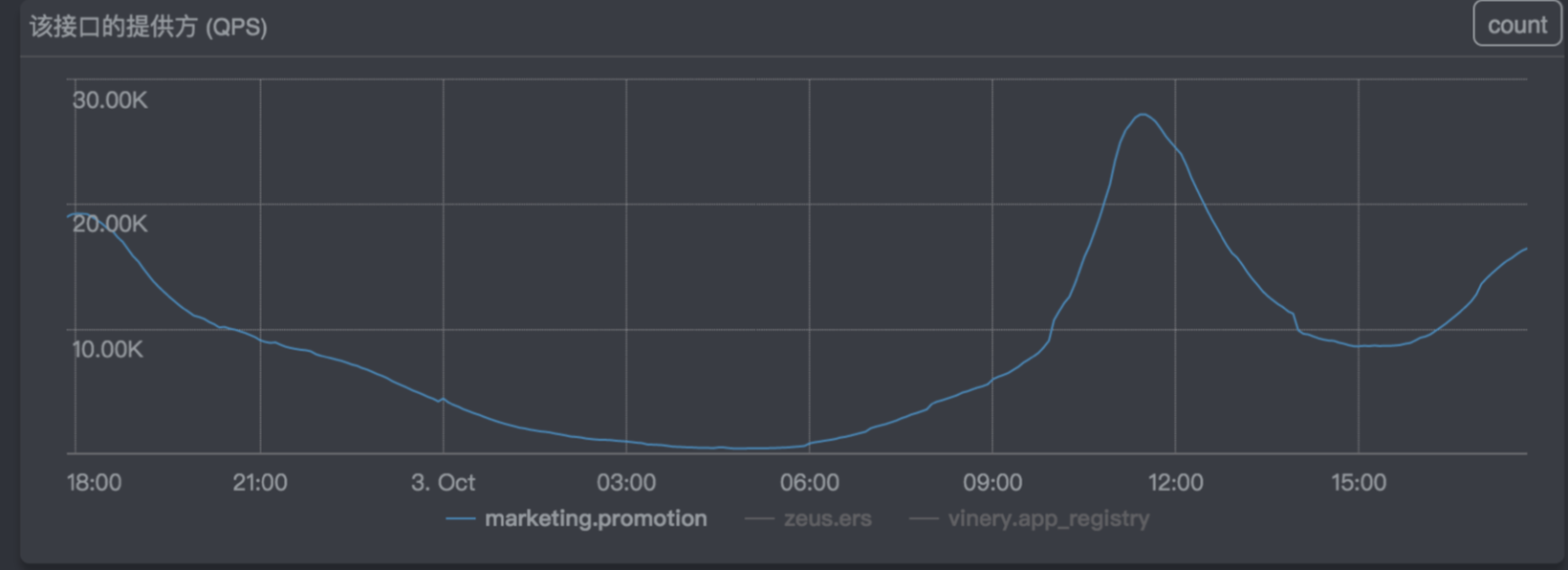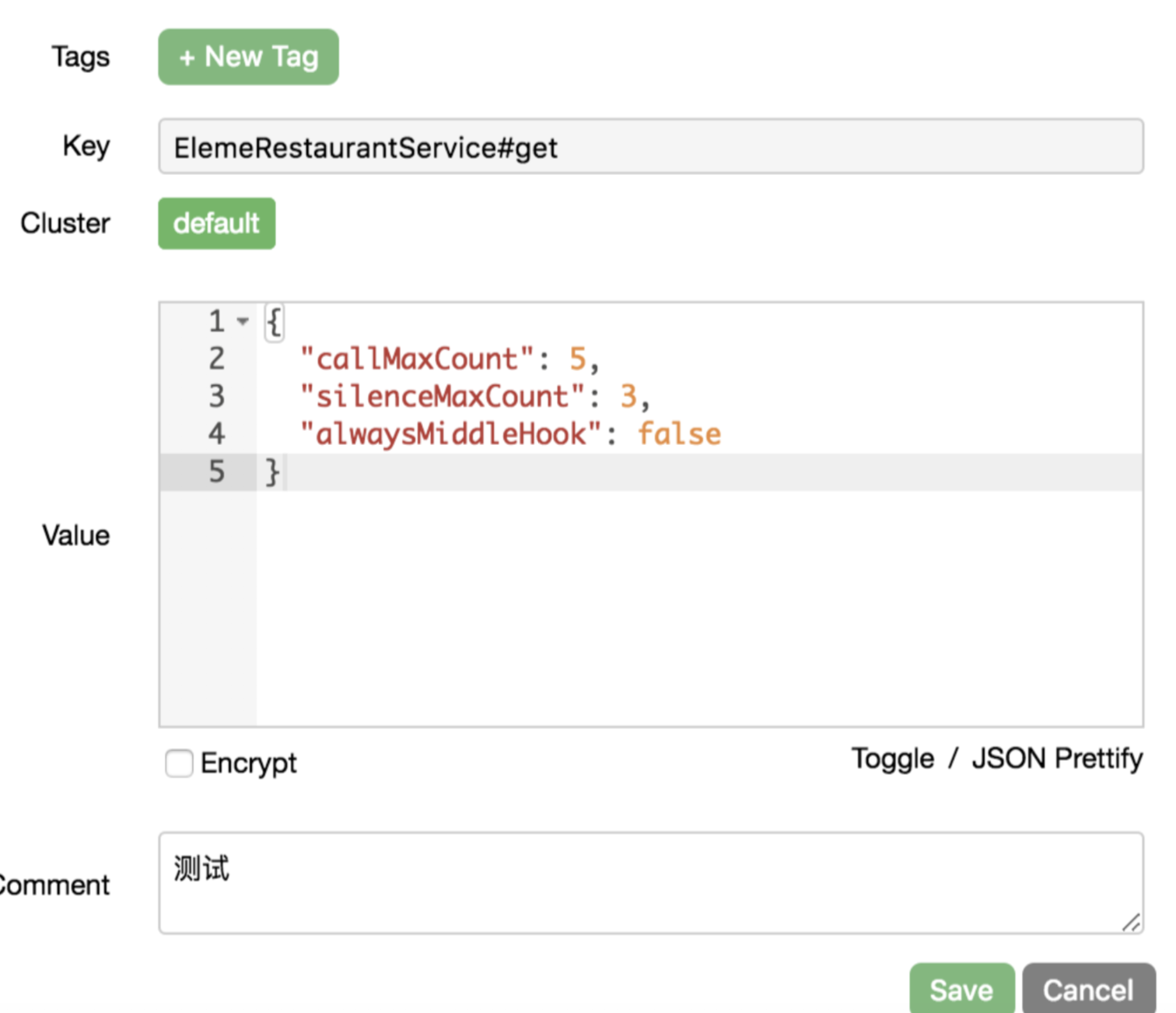简单的服务重试降级架子
简单的服务重试降级架子
背景
在微服务架构中,这种 A --调用--> B 的服务调用链路再常见不过。 当 A 服务调用 B 服务的时候经常由于一些原因(比如B服务异常宕机等)导致B服务暂时不可用。 而为了保护A服务,避免发生大规模“雪崩”、“连锁反应”等问题,基本的SOA框架(spring cloud、dubbo、pylon)等都会提供 心跳检查、熔断(分为客户端熔断 or 服务端熔断)、降级(pylon貌似只有服务端降级)。但是这些框架为了更好的适用与所有绝大多数场景,所以会相应的摒弃一些不通用的东西。
问题
当 A服务调用B服务,不能保证B服务100%可用, 也不能保证到B的网络100%可达,拿shop.core_service这个服务举例,调用营销查询配送补贴的接口 QPS 在高峰期将近30K,平均相应时间在10ms以内


但是在这30K的调用里面,存在300内的 timeout 请求(客户端限制服务端相应时间不能超过300ms,超过即超时),看下最大响应时间 发现最大值为5.322s。
这个接口的影响是:如果一次调用超时,便可能造成用户下的这一单不享受商家设置的配送费补贴(前提是下单页面调用这个接口且这家店在此时有商家补贴活动)。 这种损失无论发生在哪位用户上都会造成不良体验。
前两天听到个有趣的故事也分享下:一个制造军用降落伞的公司,制造工艺非常精细,检查制度非常严格,已经将标品的合格率提高到了99.99%,几乎无法再次提高。 军方跟降落伞公司的CEO说:“我知道你们99.99%的合格率已经非常高了,但是这也就说明我们10000个将士跳伞,就会有1个将士牺牲,这个代价是很严重的”。CEO摇了摇头:“sorry sir我们已经近了最大的努力!你要理解我们,再工艺中出现丁点偏差都会造成降落伞不合格,99.99%已经是世界上最高的合格率了,真的没有办法再提高了”。将军想了想,叹了口气说:“哎,好吧,我也理解你们,以后的采购合同还会跟你们继续保持,不过我要在合同上加一条,每次你们公司交货的时候都要从这批货中随机挑选出10个降落伞来,让top10的高管亲自跳伞验收下,然后我们再收这批货”。结果三个月之后,这家公司降落伞的合格率达到了100%。
办法
在无法保证服务100%可用的情况下,怎么做到降低失败率呢? 可能有很多种方法,我选择的是:快速失败重试。
我们计算下A调用B的服务不可用率是 0.001% ( 300/30K 得出), 如果服务调用失败的时候重试3次,则 服务不可用率即为 0.001% * 0.001% * 0.001%。
但是单纯的重试也会带来一些问题:
-
比如降低
A服务的整体性能,最差情况下本来调用B服务最多在300ms就会有返回(异常也是返回),即A服务处理一次请求最消耗500ms,单线程1s可以处理2个请求,一台机器上假设可以最多处理1k个线程的情况,即A服务接口的QPS == 2K, 100台机器最高QPS==200K, 当失败重试三次的时候, 整体的接口性能会降低到200/3 K上。怎么解决? 缩短A调用B的超时时间,把这个时间推荐设置为B接口平均相应时间upper 99线*3(具体情况具体分析)比如把上面查询补贴的接口超时时间设置为50ms,重试3次,最坏情况才损耗150ms,服务不可用率降低到了0.001% * 0.001% * 0.001%,却还能提高QPS到200K*2。就算把超时时间调整到100ms,整体服务的接口性能也不会降低 -
加了重试还会有个问题,如果
B服务挂掉了,对B服务的压力会暴增3倍(如果重试三次的话)这样A就要做好直接降级B的准备,做到一键降级。
使用姿势
根据相关业务和部门的技术栈用到了Huskar+Vine写了个简单的重试架子,先看使用姿势,后面上源码
callAndFallBack
支持FallBack的调用姿势
public class TestCallUtil extends ComponentTest {
@Inject
private ErsClient ersClient;
@Inject
private Logger logger;
public void testCallAndFallBack() {
Restaurant result = CallServiceWrapper.callAndFallBack(
new CallServiceInterfaceContext<Restaurant>() {
@Override
public Restaurant run() throws Exception {
// 必须实现,B服务的接口调用
return ersClient.get(969343L);
}
@Override
public String key() {
// 做服务降级可以使用的key
// 必须实现
return "ElemeRestaurantService#get";
}
@Override
public Restaurant fallBack() {
// 如果客户端把服务端降级掉,会直接走到fallBack里面
// 如果客户端重试次数达到最大但是仍然失败,会到fallback里面
// 可以不Override, 默认返回null
return new Restaurant();
}
@Override
public int callMaxCount() {
// 最大调用次数
// 可以不Override,默认1
return 1;
}
@Override
public int silenceMaxCount() {
// 最大沉默次数 当调用次数 > 该值的时候 会触发silenceMaxHook函数,可以在silenceMaxHook里面做监控or打点
// 可以不Override,默认1
return 1;
}
@Override
public boolean alwaysMiddleHook() {
// 当调用次数 > 最大沉默次数的时候,是否超过的部分总是触发silenceMaxHook
// 可以不Override,默认false(只触发一次)
return false;
}
@Override
public void callMaxHook(int maxCount) {
// 如果调用达到了最大次数且仍然仍然失败,会触发这个方法,主要用来打点or日志来做监控
// 可以不Override, 默认什么都不做
logger.info("最大调用次数:" + maxCount);
}
@Override
public void silenceMaxHook(int nowCount) {
// 可容忍调用的最大次数
// 比如允许调用最大次数5次,但是超过3次的已经是属于极端case了,想要感知超过三次的有多少,便可以在这里打点or日志
// 可以不Override, 默认什么都不做
logger.info("可忍受的最大次数:" + nowCount);
}
@Override
public void downgradeCompleteHook(Restaurant result) {
// 如果链路走了fallback,完成fallback之后会将fallback的返回结果传入这个方法里,方便监控,打日志等
// 可以不Override, 默认什么都不做
logger.info("降级完成钩子:" + result);
}
@Override
public void exceptionHook(Exception e) {
// 如果出现Exception,则会call一次这个接口,并且将异常信息丢进来,方便打日志
// 可以不Override, 默认什么都不做
logger.error("Exception 钩子", e.getMessage());
}
@Override
public void serviceExceptionHook(ServiceException e) {
// 如果出现ServiceException,则会call一次这个接口,并且将异常信息丢进来,方便打日志
// 可以不Override, 默认什么都不做
logger.error("ServiceException 钩子", e.getMessage());
}
@Override
public void callCompleteHook(Restaurant result) {
// 如果调用成功,会将返回返回结果先丢到这里来,方便打日志
// 可以不Override, 默认什么都不做
logger.info("调用完成钩子:" + result);
}
});
}
}
上面的代码便完成了一次服务重试 和 降级配置机制,上面把所有的可Override接口全部Orverride了, 下面给一个简单的,可以满足基本需求的实现方法
public class TestCallUtil extends ComponentTest {
@Inject
private ErsClient ersClient;
@Inject
private Logger logger;
public void testCallAndFallBack() {
Restaurant result = CallServiceWrapper.callAndFallBack(
new CallServiceInterfaceContext<Restaurant>() {
@Override
public Restaurant run() throws Exception {
// 必须实现,B服务的接口调用
return ersClient.get(969343L);
}
@Override
public String key() {
// 做服务降级可以使用的key
// 必须实现
return "ElemeRestaurantService#get";
}
@Override
public Restaurant fallBack() {
// 如果客户端把服务端降级掉,会直接走到fallBack里面
// 如果客户端重试次数达到最大但是仍然失败,会到fallback里面
// 可以不Override, 默认返回null
return new Restaurant();
}
});
}
}
这样写的话很简单,基本满足需求: 接口可降级,降级后or超过最大调用次数会走fallback方法,如果你懒一些的话 fallback都可以省略,因为fallback默认返回null。
看第二段代码是不是比较好奇,最大重试次数和最大可容忍次数都没有Override,都走默认1的话岂不是没有什么作用? No, 因为你Override了key()方法,他将帮你做到灵活配置, 只需要在Huskar的Config上面配置:

而且是随时可以改变,不需要reroll服务哦~ 不过考虑config里面的东西不太可能经常变,所以也可以适当的优化下面的源码,使其在服务初始化的时候加载一次,这样就不用每次都拉huskar config了(这也是为什么我把降级操作从config里面拆出来的一个原因)
另外一个比较方便的地方在于服务降级,肯定也是要可配置的,由于饿了么huskar switch比较适合做开关,所以我并没有把降级开关也配置在huskar config的json里面,而是单独拎出来到switch里面了,配置如图。0 为降级,100 为不降级

具体的读取配置逻辑是这样的: 在huskar中配置了的优先读取huskar配置,没有配置的读代码Override,如果连Override都没有,那就走默认值啦。不过强烈建议走huskar,不要Hard Code。
- 1 写好run()
- 2 写好key() 注意不要在string里面写
$符号,写了的话也会自动将$转换为#,避免和饿了么Soa框架pylon的接口降级冲突 - 3 写好fallback()
做好上面三步之后,便可以很愉快的在客户端把服务端的接口做重试 or 降级(这是客户端降掉服务端,pylon可不支持哦~,也可能是我代码没找到)。
⚠️ 一定要注意,业务里面有些接口是不能降级的,要评估好!
下面给个线上的代码Demo
public List<ReduceDeliveryFeeRespDto> getShopProductPromotionWithUserInfoCanDowngrade(DeliveryFeeCalculateResultDTO calculateResult, ShopDTO shopDTO) {
List<ReduceDeliveryFeeRespDto> result = new ArrayList<>();
CartInfoReqDto cartInfoReqDto = new CartInfoReqDto();
cartInfoReqDto.setRestaurant_id(calculateResult.getShopId());
cartInfoReqDto.setStandardId(calculateResult.getProductId());
ReduceDeliveryFeeRespDto reduceDeliveryFeeRespDto = calculateReduceDeliveryFee(cartInfoReqDto);
if (reduceDeliveryFeeRespDto != null) {
result.add(reduceDeliveryFeeRespDto);
}
return result;
}
private ReduceDeliveryFeeRespDto calculateReduceDeliveryFee(CartInfoReqDto request) {
if (request == null) {
return null;
}
ReduceDeliveryFeeRespDto result = CallServiceWrapper.callAndFallBack(
new CallServiceInterfaceContext<ReduceDeliveryFeeRespDto>() {
@Override
public ReduceDeliveryFeeRespDto run() throws Exception {
return marketingActivityPromotionService.calculateReduceDeliveryFee(request);
}
@Override
public String key() {
return "MarketingActivityPromotionService#calculateReduceDeliveryFee";
}
@Override
public ReduceDeliveryFeeRespDto fallBack() {
return null;
}
@Override
public void serviceExceptionHook(me.ele.contract.exception.ServiceException e) {
logger.error(String.format(
"MarketingActivityPromotionService.calculateReduceDeliveryFee ServiceException, request:%s",
VJson.writeAsString(request)), e);
}
@Override
public void exceptionHook(Exception e) {
logger.error(String.format(
"MarketingActivityPromotionService.calculateReduceDeliveryFee Exception, request:%s",
VJson.writeAsString(request)), e);
}
@Override
public void downgradeCompleteHook(ReduceDeliveryFeeRespDto result) {
Trace.newCounter("calculate-downgrade")
.addTag("source", "marketing")
.addTag("method", "calculate-reduce-delivery-fee")
.once();
}
@Override
public void silenceMaxHook(int nowCount) {
Trace.newCounter("call-silence")
.addTag("class", "MarketingActivityPromotionService")
.addTag("method", "calculateReduceDeliveryFee")
.addTag("count", nowCount + "")
.once();
}
});
return result;
}
call
不做FallBack的调用
这个与callAndFallBack的区别就是当发生降级操作 or 重试达到调用上限后不会调用fallback函数,直接抛Exception出来。
- 降级后的Exception就是
new Exception(String.format("%s已经降级", key())) - 重试无效后的Exception就是最后失败时run方法抛出来的Exception
使用代码基本没有变
public void testCall() {
try {
Restaurant result = CallServiceWrapper.call( //就这里不一样
new CallServiceInterfaceContext<Restaurant>() {
@Override
public Restaurant run() throws Exception {
logger.info("ers.get" + 969343L);
throw new Exception("fuck Exception");
}
@Override
public String key() {
return "ElemeRestaurantService#get";
}
@Override
public Restaurant fallBack() {
return new Restaurant();
}
@Override
public void callMaxHook(int maxCount) {
logger.info("最大调用次数:" + maxCount);
}
@Override
public void silenceMaxHook(int nowCount) {
logger.info("当前调用次数:" + nowCount + ", 已经不能忍受");
}
@Override
public void downgradeCompleteHook(Restaurant result) {
logger.info("降级完成钩子:" + result);
}
@Override
public void exceptionHook(Exception e) {
logger.error("Exception 钩子", e.getMessage());
}
@Override
public void serviceExceptionHook(ServiceException e) {
logger.error("ServiceException 钩子", e.getMessage());
}
@Override
public void callCompleteHook(Restaurant result) {
logger.info("调用完成钩子:" + result);
}
});
} catch (Exception e) {
e.printStackTrace();
}
}
callNotCoverServiceException
顾名思义,不去重试ServiceException,如果出新ServiceException,直接中断重试,抛出异常。 其他Exception会继续retry,直到达到retry最大值,将最后一次触发得到的异常抛出来。
如果接口被降级,则抛一个new ServiceException(String.format("%s已经降级", serviceInterfaceContext.key()));, 不会走到fallback里面
使用姿势:
public void testCallNotCoverServiceException() {
try {
Restaurant result = CallServiceWrapper.callNotCoverServiceException(
new CallServiceInterfaceContext<Restaurant>() {
@Override
public Restaurant run() throws Exception {
logger.info("ers.get" + 969343L);
throw new ServiceException("fuck Service Exception");
}
@Override
public String key() {
return "ElemeRestaurantService#get";
}
@Override
public Restaurant fallBack() {
return new Restaurant();
}
@Override
public void callMaxHook(int maxCount) {
logger.info("最大调用次数:" + maxCount);
}
@Override
public void silenceMaxHook(int nowCount) {
logger.info("当前调用次数:" + nowCount + ", 已经不能忍受");
}
@Override
public void downgradeCompleteHook(Restaurant result) {
logger.info("降级完成钩子:" + result);
}
@Override
public void exceptionHook(Exception e) {
logger.error("Exception 钩子", e.getMessage());
}
@Override
public void serviceExceptionHook(ServiceException e) {
logger.error("ServiceException 钩子", e.getMessage());
}
@Override
public void callCompleteHook(Restaurant result) {
logger.info("调用完成钩子:" + result);
}
});
} catch (Exception e) {
e.printStackTrace();
}
}
callNotCoverServiceExceptionAndFallBack
这个就是 不去覆盖ServiceException,但是当出现 其他Exception的时候会做重试,直到重试到最大值后 调用fallback。
当触发接口降级的时候也是调用fallback,并不抛异常
使用姿势:
public void testCallNotCoverServiceExceptionAndFallBack() {
try {
Restaurant result = CallServiceWrapper.callNotCoverServiceExceptionAndFallBack(
new CallServiceInterfaceContext<Restaurant>() {
@Override
public Restaurant run() throws Exception {
logger.info("ers.get" + 969343L);
throw new ServiceException("fuck Service Exception");
}
@Override
public String key() {
return "ElemeRestaurantService#get";
}
@Override
public Restaurant fallBack() {
return new Restaurant();
}
@Override
public void callMaxHook(int maxCount) {
logger.info("最大调用次数:" + maxCount);
}
@Override
public void silenceMaxHook(int nowCount) {
logger.info("当前调用次数:" + nowCount + ", 已经不能忍受");
}
@Override
public void downgradeCompleteHook(Restaurant result) {
logger.info("降级完成钩子:" + result);
}
@Override
public void exceptionHook(Exception e) {
logger.error("Exception 钩子", e.getMessage());
}
@Override
public void serviceExceptionHook(ServiceException e) {
logger.error("ServiceException 钩子", e.getMessage());
}
@Override
public void callCompleteHook(Restaurant result) {
logger.info("调用完成钩子:" + result);
}
});
} catch (Exception e) {
e.printStackTrace();
}
}
源码
源码很简单,各位将代码贴到自己项目里面,可以定制化的修改开发:
CallServiceInterfaceContext
import me.ele.config.HuskarHandle;
import me.ele.contract.exception.ServiceException;
import me.ele.napos.vine.common.json.VJson;
import javax.validation.constraints.NotNull;
public abstract class CallServiceInterfaceContext<T> {
/**
* 真正的接口调用,比如实现
*/
public abstract T run() throws Exception;
/**
* huskar key,为null的话会默认不使用
*/
public abstract String key();
/**
* 降级处理
*/
public T fallBack() {
return null;
}
/**
* 接口调用次数最大值
* <p>
* return 1: 只允许接口调用一次,就算是这次失败了也不回继续调用
* return n (n>1): 允许接口调用n次,如果第1次失败了,还可以重试n-1次
*/
public int callMaxCount() {
return 1;
}
/**
* 可容忍最大调用次数
* <p>
* return 1: 当调用服务接口次数超过1, 则超过1的调用触发silenceMaxHook
* return n: 当调用服务接口次数超过n, 则超过n的调用触发silenceMaxHook
* <p>
* 注意当silenceMaxCount>=callMaxCount的时候, 将永远不会触发silenceMaxHook
*/
public int silenceMaxCount() {
return 1;
}
/**
* 当调用次数 > 可容忍值后是否总是触发 silenceMaxHook
* <p>
* return false: 超过的部分只会触发一次silenceMaxHook
* return true: 超过的部分总是触发silenceMaxHook
*/
public boolean alwaysMiddleHook() {
return false;
}
/**
* 重试达到最大值后call back
* @param maxCount 调用最大值
*/
public void callMaxHook(int maxCount) {
}
/**
* 超过可容忍最大调用次数 call back
* @param nowCount 调用当前次数
*/
public void silenceMaxHook(int nowCount) {
}
/**
* 降级完成
* @param result 如果调用fallBack,则会将fallBack返回值当作result参数
*/
public void downgradeCompleteHook(T result) {
}
/**
* 服务异常钩子
*/
public void serviceExceptionHook(ServiceException e) {
}
/**
* 异常钩子
* @param e 异常信息
*/
public void exceptionHook(Exception e) {
}
/**
* 服务调用完成钩子
* @param result 服务调用结果
*/
public void callCompleteHook(T result) {
}
/**
* 获取huskar key
*/
public final String huskarKey() {
// 将所有的$转换成#,避免跟pylon降级冲突
return key() == null ? "" : key().replaceAll("\\$", "#");
}
/**
* 降级
* <p>
* return true: 开启降级
* return false: 关闭降级
*/
public final boolean downgrade() {
// huskar switch 中 huskarkey的值 < 50, 则降级掉
int value = HuskarHandle.get().getMySwitch().getInt(huskarKey(), 100);
return value < 50;
}
/**
* 调用服务配置
* 1. 可以根据 huskarKey 配置在huskar config上
* 2. 如果huskar中读取不到或者读取错误, 则使用 Override callMaxCount,silenceMaxCount,alwaysMiddleHook
*/
public final CallServiceInterfaceConfig config() {
String huskarValue = "";
if (huskarKey() == null || huskarKey().trim().isEmpty()) {
huskarValue = "";
} else {
huskarValue = HuskarHandle.get().getMyConfig().getProperty(huskarKey(), "");
}
CallServiceInterfaceConfig callServiceInterfaceConfig = CallServiceInterfaceConfig.getInstanceByJsonString(huskarValue);
if (callServiceInterfaceConfig == null) {
callServiceInterfaceConfig = CallServiceInterfaceConfig.getInstanceByValue(callMaxCount(), silenceMaxCount(), alwaysMiddleHook());
}
return callServiceInterfaceConfig;
}
protected static class CallServiceInterfaceConfig{
private int callMaxCount = 1;
private int silenceMaxCount = 1;
private boolean alwaysMiddleHook = false;
private void setCallMaxCount(int callMaxCount) {
this.callMaxCount = callMaxCount;
}
private void setSilenceMaxCount(int silenceMaxCount) {
this.silenceMaxCount = silenceMaxCount;
}
private void setAlwaysMiddleHook(boolean alwaysMiddleHook) {
this.alwaysMiddleHook = alwaysMiddleHook;
}
protected int getCallMaxCount() {
return callMaxCount;
}
protected int getSilenceMaxCount() {
return silenceMaxCount;
}
protected boolean isAlwaysMiddleHook() {
return alwaysMiddleHook;
}
private static CallServiceInterfaceConfig getInstanceByJsonString(String jsonString) {
if (jsonString == null || jsonString.isEmpty()) {
return null;
} else {
try {
return VJson.read(jsonString, CallServiceInterfaceConfig.class);
} catch (Exception e) {
return null;
}
}
}
private static CallServiceInterfaceConfig getInstanceByValue(int callMaxCount, int silenceMaxCount, boolean alwaysMiddleHook) {
CallServiceInterfaceConfig callServiceInterfaceConfig = new CallServiceInterfaceConfig();
callServiceInterfaceConfig.setCallMaxCount(callMaxCount);
callServiceInterfaceConfig.setSilenceMaxCount(silenceMaxCount);
callServiceInterfaceConfig.setAlwaysMiddleHook(alwaysMiddleHook);
return callServiceInterfaceConfig;
}
}
}
CallServiceWrapper
import me.ele.contract.exception.ServiceException;
public abstract class CallServiceWrapper {
/**
* 0 降级开关关闭,服务正常响应,正常返回
* 1 降级开关关闭,服务异常,走重试逻辑,重试达到最大值走fallback&hook
* 2 降级开关打开,走fallback&hook
*/
public static <T> T callAndFallBack(CallServiceInterfaceContext<T> serviceInterfaceContext) {
if (serviceInterfaceContext.downgrade()) {
// 接口被降级,则直接callBack,并且触发downgradeCompleteHook
T callBackResult = serviceInterfaceContext.fallBack();
serviceInterfaceContext.downgradeCompleteHook(callBackResult);
return callBackResult;
}
boolean middleHook = false;
CallServiceInterfaceContext.CallServiceInterfaceConfig config = serviceInterfaceContext.config();
for (int i = 1; i <= config.getCallMaxCount(); i++) {
try {
T callResult = serviceInterfaceContext.run();
serviceInterfaceContext.callCompleteHook(callResult);
return callResult;
} catch (ServiceException e) {
serviceInterfaceContext.serviceExceptionHook(e);
} catch (Exception e) {
serviceInterfaceContext.exceptionHook(e);
}
// 当调用次数超过可容忍次数后时候触发silenceMaxHook
if (i > config.getSilenceMaxCount() && !middleHook) {
serviceInterfaceContext.silenceMaxHook(i);
// 没有打开alwaysMiddleHook的话 只触发一次middleHook
if (!config.isAlwaysMiddleHook()) {
middleHook = true;
}
}
}
// 重试次数达到 retryMaxCount 则触发retryMaxHook
serviceInterfaceContext.callMaxHook(serviceInterfaceContext.callMaxCount());
// 重试最大 调用fallBack
T callBackResult = serviceInterfaceContext.fallBack();
serviceInterfaceContext.downgradeCompleteHook(callBackResult);
return callBackResult;
}
/**
* 0 降级开关关闭,服务正常响应,正常返回
* 1 降级开关关闭,服务异常走重试逻辑,重试满只会抛最后一次重试的异常
* 2 降级开关打开,抛接口已降级异常
*/
public static <T> T call(CallServiceInterfaceContext<T> serviceInterfaceContext) throws Exception {
if (serviceInterfaceContext.downgrade()) {
// 接口被降级,直接抛Exception
// 这里downgradeCompleteHook传入null, 因为没有结果也没有什么可以传入的
serviceInterfaceContext.downgradeCompleteHook(null);
throw new Exception(String.format("%s已经降级", serviceInterfaceContext.huskarKey()));
}
boolean middleHook = false;
Exception exception = null;
CallServiceInterfaceContext.CallServiceInterfaceConfig config = serviceInterfaceContext.config();
for (int i = 0; i <= config.getCallMaxCount(); i++) {
try {
T callResult = serviceInterfaceContext.run();
serviceInterfaceContext.callCompleteHook(callResult);
return callResult;
} catch (ServiceException e) {
serviceInterfaceContext.serviceExceptionHook(e);
exception = e;
} catch (Exception e) {
serviceInterfaceContext.exceptionHook(e);
exception = e;
}
// 当调用次数超过可容忍次数后时候触发silenceMaxHook
if (i > config.getSilenceMaxCount() && !middleHook) {
serviceInterfaceContext.silenceMaxHook(i);
// 没有打开alwaysMiddleHook的话 只触发一次middleHook
if (!config.isAlwaysMiddleHook()) {
middleHook = true;
}
}
}
// 重试次数达到 retryMaxCount 则触发retryMaxHook
serviceInterfaceContext.callMaxHook(config.getCallMaxCount());
// 抛出最有一次异常信息
throw exception == null ? new Exception("无异常信息") : exception;
}
/**
* 0 降级开关关闭,服务正常响应,正常返回
* 1 降级开关关闭,ServiceException 直接抛,Exception走重试,重试满了抛Exception
* 2 降级开关打开,抛接口已经降级的ServiceException
*/
public static <T> T callNotCoverServiceException(CallServiceInterfaceContext<T> serviceInterfaceContext) throws Exception {
if (serviceInterfaceContext.downgrade()) {
// 接口被降级,直接抛Exception
// 这里downgradeCompleteHook传入null, 因为没有结果也没有什么可以传入的
serviceInterfaceContext.downgradeCompleteHook(null);
throw new ServiceException(String.format("%s已经降级", serviceInterfaceContext.huskarKey()));
}
boolean middleHook = false;
Exception exception = null;
CallServiceInterfaceContext.CallServiceInterfaceConfig config = serviceInterfaceContext.config();
for (int i = 0; i <= config.getCallMaxCount(); i++) {
try {
T callResult = serviceInterfaceContext.run();
serviceInterfaceContext.callCompleteHook(callResult);
return callResult;
} catch (ServiceException e) {
serviceInterfaceContext.serviceExceptionHook(e);
throw e;
} catch (Exception e) {
serviceInterfaceContext.exceptionHook(e);
exception = e;
}
// 当调用次数超过可容忍次数后时候触发silenceMaxHook
if (i > config.getSilenceMaxCount() && !middleHook) {
serviceInterfaceContext.silenceMaxHook(i);
// 没有打开alwaysMiddleHook的话 只触发一次middleHook
if (!config.isAlwaysMiddleHook()) {
middleHook = true;
}
}
}
// 重试次数达到 retryMaxCount 则触发retryMaxHook
serviceInterfaceContext.callMaxHook(serviceInterfaceContext.callMaxCount());
// 抛出最后一次异常信息
throw exception == null ? new ServiceException("无异常信息") : exception;
}
/**
* 0 降级开关关闭,服务正常响应,正常返回
* 1 降级开关关闭,ServiceException 直接抛,Exception走重试,重试满了走 ballback&hook
* 2 降级开关打开,直接走 fallback&hook
*/
public static <T> T callNotCoverServiceExceptionAndFallBack(CallServiceInterfaceContext<T> serviceInterfaceContext) throws Exception {
if (serviceInterfaceContext.downgrade()) {
// 接口被降级,则直接callBack,并且触发downgradeCompleteHook
T callBackResult = serviceInterfaceContext.fallBack();
serviceInterfaceContext.downgradeCompleteHook(callBackResult);
return callBackResult;
}
boolean middleHook = false;
CallServiceInterfaceContext.CallServiceInterfaceConfig config = serviceInterfaceContext.config();
for (int i = 0; i <= config.getCallMaxCount(); i++) {
try {
T callResult = serviceInterfaceContext.run();
serviceInterfaceContext.callCompleteHook(callResult);
return callResult;
} catch (ServiceException e) {
serviceInterfaceContext.serviceExceptionHook(e);
throw e;
} catch (Exception e) {
serviceInterfaceContext.exceptionHook(e);
}
// 当调用次数超过可容忍次数后时候触发silenceMaxHook
if (i > config.getSilenceMaxCount() && !middleHook) {
serviceInterfaceContext.silenceMaxHook(i);
// 没有打开alwaysMiddleHook的话 只触发一次middleHook
if (!config.isAlwaysMiddleHook()) {
middleHook = true;
}
}
}
// 重试次数达到 retryMaxCount 则触发retryMaxHook
serviceInterfaceContext.callMaxHook(serviceInterfaceContext.callMaxCount());
// 重试最大 调用fallBack
T callBackResult = serviceInterfaceContext.fallBack();
serviceInterfaceContext.downgradeCompleteHook(callBackResult);
return callBackResult;
}
}